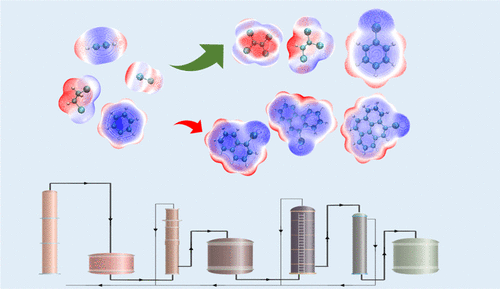当前位置:
X-MOL 学术
›
Environ. Sci. Technol.
›
论文详情
Our official English website, www.x-mol.net, welcomes your
feedback! (Note: you will need to create a separate account there.)
Insights into the Formation and Profile of Chlorinated Polycyclic Aromatic Hydrocarbons during Chlorobenzene and Chloroethylene Manufacturing Processes
Environmental Science & Technology ( IF 10.8 ) Pub Date : 2021-11-23 , DOI: 10.1021/acs.est.1c05688 Xiaoyun Liu 1, 2 , Lili Yang 1, 2 , Minxiang Wang 1, 2 , Minghui Zheng 1, 2, 3 , Cui Li 1, 2 , Linjun Qin 1, 2 , Guorui Liu 1, 2, 3
Environmental Science & Technology ( IF 10.8 ) Pub Date : 2021-11-23 , DOI: 10.1021/acs.est.1c05688 Xiaoyun Liu 1, 2 , Lili Yang 1, 2 , Minxiang Wang 1, 2 , Minghui Zheng 1, 2, 3 , Cui Li 1, 2 , Linjun Qin 1, 2 , Guorui Liu 1, 2, 3
Affiliation

|
Chlorinated polycyclic aromatic hydrocarbons including chlorinated naphthalenes and congeners with three to five rings are ubiquitous atmospheric pollutants. Congener profiles and formation mechanisms from typical chemical manufacturing have not been researched extensively. We measured the concentrations of 75 chlorinated naphthalenes and 18 chlorinated polycyclic aromatic hydrocarbons in raw materials, intermediates, products, and bottom residues from chemical plants producing monochlorobenzene and chloroethylene by different techniques. The findings confirmed that these chemical manufacturing processes are newly identified sources of atmospheric emissions of these compounds. More-chlorinated naphthalenes were formed from chloroethylene production than from monochlorobenzene production, which could be explained by the higher temperatures in the former process. Successive chlorination appeared to be an important formation pathway of polychlorinated naphthalenes according to their congener profiles and was supported by quantum chemical calculations of electrophilic chlorination on various positions of naphthalene. Chlorinated polycyclic aromatic hydrocarbons were more likely to be formed during the production of monochlorobenzene than chloroethylene. Moreover, we suggested that ring rearrangement and ring coupling are important transformation reactions between polychlorinated naphthalenes and chlorinated polycyclic aromatic hydrocarbons.
中文翻译:

深入了解氯苯和氯乙烯制造过程中氯化多环芳烃的形成和分布
氯化多环芳烃,包括氯化萘和三至五环的同系物,是普遍存在的大气污染物。来自典型化学制造的同源物分布和形成机制尚未得到广泛研究。我们通过不同技术测定了生产一氯苯和氯乙烯的化工厂的原料、中间体、产品和底部残留物中的75种氯化萘和18种氯化多环芳烃的浓度。调查结果证实,这些化学制造过程是新发现的这些化合物的大气排放源。氯乙烯生产中形成的氯化萘多于一氯苯生产中,这可以用前一个过程中较高的温度来解释。根据其同系物谱,连续氯化似乎是多氯化萘的重要形成途径,并得到了萘不同位置亲电氯化的量子化学计算的支持。与氯乙烯相比,一氯苯在生产过程中更容易形成氯化多环芳烃。此外,我们认为环重排和环偶联是多氯化萘和氯化多环芳烃之间的重要转化反应。根据其同系物谱,连续氯化似乎是多氯化萘的重要形成途径,并得到了萘不同位置亲电氯化的量子化学计算的支持。与氯乙烯相比,一氯苯在生产过程中更容易形成氯化多环芳烃。此外,我们认为环重排和环偶联是多氯化萘和氯化多环芳烃之间的重要转化反应。根据其同系物谱,连续氯化似乎是多氯化萘的重要形成途径,并得到了萘不同位置亲电氯化的量子化学计算的支持。与氯乙烯相比,一氯苯在生产过程中更容易形成氯化多环芳烃。此外,我们认为环重排和环偶联是多氯化萘和氯化多环芳烃之间的重要转化反应。
更新日期:2021-12-07
中文翻译:

深入了解氯苯和氯乙烯制造过程中氯化多环芳烃的形成和分布
氯化多环芳烃,包括氯化萘和三至五环的同系物,是普遍存在的大气污染物。来自典型化学制造的同源物分布和形成机制尚未得到广泛研究。我们通过不同技术测定了生产一氯苯和氯乙烯的化工厂的原料、中间体、产品和底部残留物中的75种氯化萘和18种氯化多环芳烃的浓度。调查结果证实,这些化学制造过程是新发现的这些化合物的大气排放源。氯乙烯生产中形成的氯化萘多于一氯苯生产中,这可以用前一个过程中较高的温度来解释。根据其同系物谱,连续氯化似乎是多氯化萘的重要形成途径,并得到了萘不同位置亲电氯化的量子化学计算的支持。与氯乙烯相比,一氯苯在生产过程中更容易形成氯化多环芳烃。此外,我们认为环重排和环偶联是多氯化萘和氯化多环芳烃之间的重要转化反应。根据其同系物谱,连续氯化似乎是多氯化萘的重要形成途径,并得到了萘不同位置亲电氯化的量子化学计算的支持。与氯乙烯相比,一氯苯在生产过程中更容易形成氯化多环芳烃。此外,我们认为环重排和环偶联是多氯化萘和氯化多环芳烃之间的重要转化反应。根据其同系物谱,连续氯化似乎是多氯化萘的重要形成途径,并得到了萘不同位置亲电氯化的量子化学计算的支持。与氯乙烯相比,一氯苯在生产过程中更容易形成氯化多环芳烃。此外,我们认为环重排和环偶联是多氯化萘和氯化多环芳烃之间的重要转化反应。










































 京公网安备 11010802027423号
京公网安备 11010802027423号